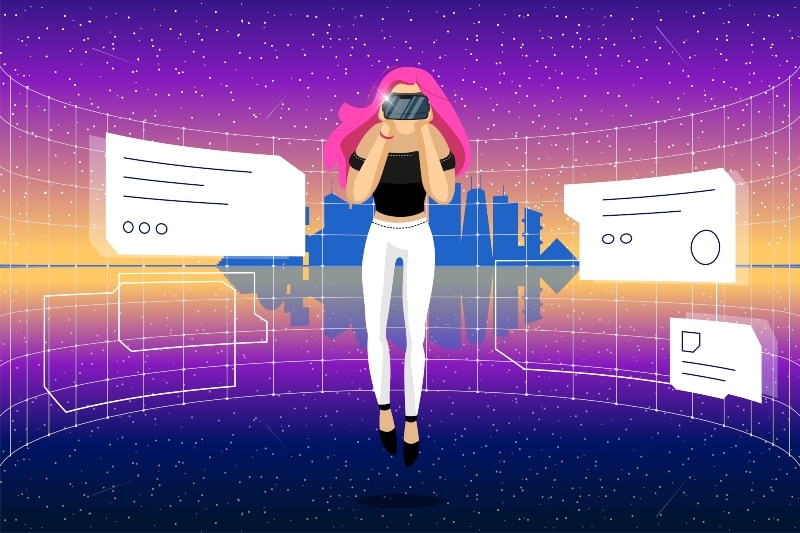The Metaverse has received great attention in recent months after Meta (formerly Facebook) announced that it would focus on this technology and experience in the coming years.
By using an avatar within these virtual worlds, it is possible to move around and interact with other users making innovative experiences, an example we have seen on the web with long-standing metaverses such as the famous Second Life.
Currently, more than 350 million people are using and having experiences in the metaverse: it is estimated that by 2030 the market value may reach $13 trillion (source: Citigroup)
It is no coincidence that brands and large companies have begun to imagine how they can introduce their presence within these virtual spaces to take advantage of all the opportunities.
A few examples?
In the summer of 2021, Coca-Cola launched its first NFTs representing the brand’s most iconic objects, and then held an event in the Decentraland metaverse, where the goal was to spot the large can of Coca-Cola placed inside.
Singer Snoop Dogg, on the other hand, created as many as 10,000 NFTs representing his avatar, which can be used in The Sandbox metaverse. We can call it an innovative virtual merchandising campaign.
Fashion brands

The metaverse provides an excellent opportunity for fashion retail to build alternatives to classic in-store or e-commerce shopping.
In addition, there is also a chance to do brand awareness by going to intercept a young target using a language familiar to them.
To date, fashion is the sector that is taking advantage of this trend the most, thanks in part to the interest that has been created around NFTs: it is possible to create unique collections that can then gain value over time and be resold, as well as displayed on social media or even used in the metaverse by having one’s avatar wear them.
But which fashion brands are currently using these technologies? Let’s look at some examples.
Burberry
Burberry launched an NFT collection of 750 pieces within the Blankos Block Party video game that sold out in a few hours.
Within this Metaverse, it is possible to play different games and socialize with other users in a dedicated space.
The new NFT collection will include other Burberry pieces, including boomboxes, TB sliders, horseshoe necklaces, and a “Shellphone,” a shell-inspired cell phone accessory that players can add to their virtual portfolio of online accessories.
Dolce & Gabbana
During the first Metaverse Fashion Week, held in the Decentraland metaverse this past March, Dolce & Gabbana presented a collection consisting of twenty looks wearable in virtual reality and created exclusively to celebrate innovation brought by the event.
The first NFT collection called Genesis was released in the fall of 2021 and immediately proved to be a success: nine digital couture pieces inspired by Venetian history and traditions were created, and sales reached 2,000 ETH, which currently corresponds to about $2 million.
Louis Vuitton
On the occasion of the 200th anniversary since the birth of founder Louis Vuitton, celebrated in August 2021, the video game Louis: The Game was launched and was an opportunity to approach the NFT world.
The video game, which follows the adventures of Vivienne, the company’s mascot, has at its core 30 NFTs that players can collect along the way. Ten of them were created by the famous digital artist Beeple.
Amarossa
Amarossa, an Italian shoe brand, announced a few days ago the launch of a limited-edition Capsule Collection – 100 total numbered pieces with the collection’s exclusive serial number on the sole – in which each “physical” model also has its virtual counterpart, in the form of NFTs that can be used in the Decentraland metaverse.
This is a project carried out in collaboration with FiloBlu S.p.A, which was created not only with the aim of innovation, but also to extend the concept of sustainability to an expanding market such as the Metaverse.
At the time of the purchase, the buyer will simply have to enter their digital wallet and then receive, about a week later, their collectible Metaverse shoes in NFT format.
Beyond the undoubted intrinsic value of these eco-friendly shoes, the real added value of the Amarossa proposal is precisely the possibility of using it in the metaverse.
To date, in fact, there is no brand that associates a physical purchase with a virtual one. At least not for free, as we have seen.
Each virtual shoe will give the opportunity to walk through the streets of the world of Decentraland showing off the Made in Italy Amarossa style, interacting and socializing with other users and taking part in the city’s economy.
These examples we have listed show how established companies in the fashion field are moving rapidly of the field of metaverse with main focus on those that work by exploiting blockchain and thus giving the possibility to create NFTs whose uniqueness and originality is guaranteed by the very underlying technology.
There will be more and more possibilities, and the combination of metaverse and the world of gaming will lead brands to seek more and more space within these virtual spaces, which will serve as a digital window for future users.

